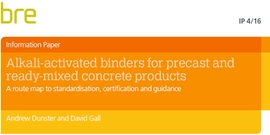Alkali-activated binders for precast and ready-mixed concrete products: A route map to standardisation, certification and guidance
BRE (The Building Research Establishment) is an independent, research-based consultancy, testing and training organisation, operating in the built environment and associated industries.
On 30 June 2016 BRE published Alkali-activated binders for precast and ready-mixed concrete products: A route map to standardisation, certification and guidance, an information paper written by Andrew Dunster and David Gall.
According to the paper, approximately 5% of human-generated CO2 emissions result from cement production. There is a need to develop alternative, low-carbon cements and binders that are suitable for use at scale in concrete production. Alkali-activated binders (AA binders) and concretes produce less CO2 in their manufacture than conventional Portland cement (PC).
To facilitate this change, the standardisation and certification of AA binders and concretes will be necessary, however, most of the world’s cement and concrete standards are underpinned by BS EN 197 and ASTM C150/C595/C1157, both of which are based around PC. Supporting guidance, experience in use and codes of practice are needed underpin the wider acceptance of AA binders as construction materials.
This information paper summarises the current position from a UK perspective and provides support for those developing, adopting and utilising AA binders. It is intended to inform purchasers and specifiers of concrete and concrete products and those with a wider interest in the procurement of sustainable construction products.
The contents of the report are:
- -Cement and concrete standards: the global context.
- -Alkali-activated binders.
- -British and European Standards for concrete.
- -Alkali-activated binders, standards and CE marking.
- -Demonstration of compliance/declaration of performance of alkali-activated binders.
- Potential routes to standardisation, certification and guidance for alkali-activated binder concrete products and binder systems.
- -Standards, specifications and third-party certification.
- -Alkali-activated binders: the need for supplementary guidance documents.
- Discussion.
- Code and standard requirements for alkali-activated binders: a longer-term view.
- Conclusion/recommendations.
- Further reading.
- References.
[edit] Related articles on Designing Buildings Wiki
- Alkali-activated binders for precast and ready-mixed concrete products: New supply chains, business models and environmental benefits.
- Alkali-aggregate reaction (AAR).
- Applications, performance characteristics and environmental benefits of alkali-activated binder concretes.
- BRE articles on Designing Buildings Wiki.
- Building Research Establishment.
- Cement.
- Concrete.
- High alumina cement.
- Research on novel cements to reduce CO2 emissions.
- Sustainable materials.
Featured articles and news
Government consultations for the summer of 2025
A year of Labour, past and present consultations on the environment, the built environment, training and tax.
CMA competitiveness probe of major housing developers
100 million affordable housing contributions committed with further consultation published.
Homes England supports Greencore Homes
42 new build affordable sustainable homes in Oxfordshire.
Zero carbon social housing: unlocking brownfield potential
Seven ZEDpod strategies for brownfield housing success.
CIOB report; a blueprint for SDGs and the built environment
Pairing the Sustainable Development Goals with projects.
Types, tests, standards and fires relating to external cladding
Brief descriptions with an extensive list of fires for review.
Latest Build UK Building Safety Regime explainer published
Key elements in one short, now updated document.
UKGBC launch the UK Climate Resilience Roadmap
First guidance of its kind on direct climate impacts for the built environment and how it can adapt.
CLC Health, Safety and Wellbeing Strategy 2025
Launched by the Minister for Industry to look at fatalities on site, improving mental health and other issues.
One of the most impressive Victorian architects. Book review.
Common Assessment Standard now with building safety
New CAS update now includes mandatory building safety questions.
RTPI leader to become new CIOB Chief Executive Officer
Dr Victoria Hills MRTPI, FICE to take over after Caroline Gumble’s departure.
Social and affordable housing, a long term plan for delivery
The “Delivering a Decade of Renewal for Social and Affordable Housing” strategy sets out future path.
A change to adoptive architecture
Effects of global weather warming on architectural detailing, material choice and human interaction.
The proposed publicly owned and backed subsidiary of Homes England, to facilitate new homes.
How big is the problem and what can we do to mitigate the effects?
Overheating guidance and tools for building designers
A number of cool guides to help with the heat.
The UK's Modern Industrial Strategy: A 10 year plan
Previous consultation criticism, current key elements and general support with some persisting reservations.
Building Safety Regulator reforms
New roles, new staff and a new fast track service pave the way for a single construction regulator.


























